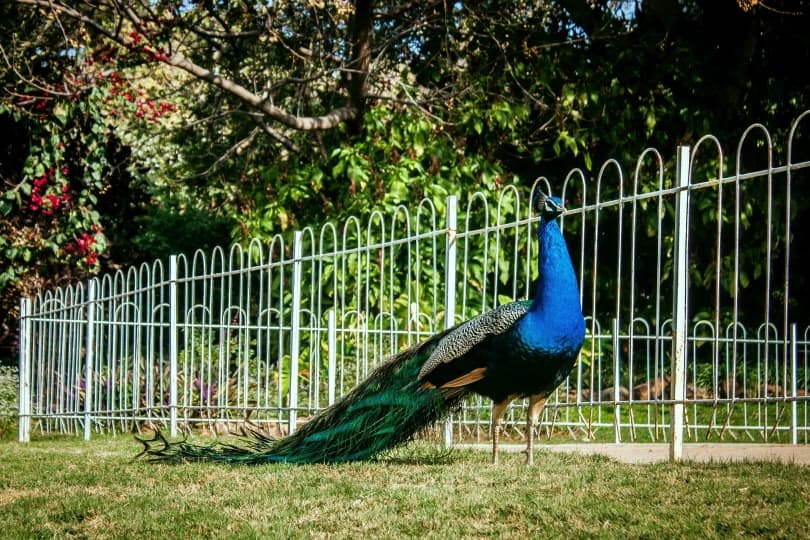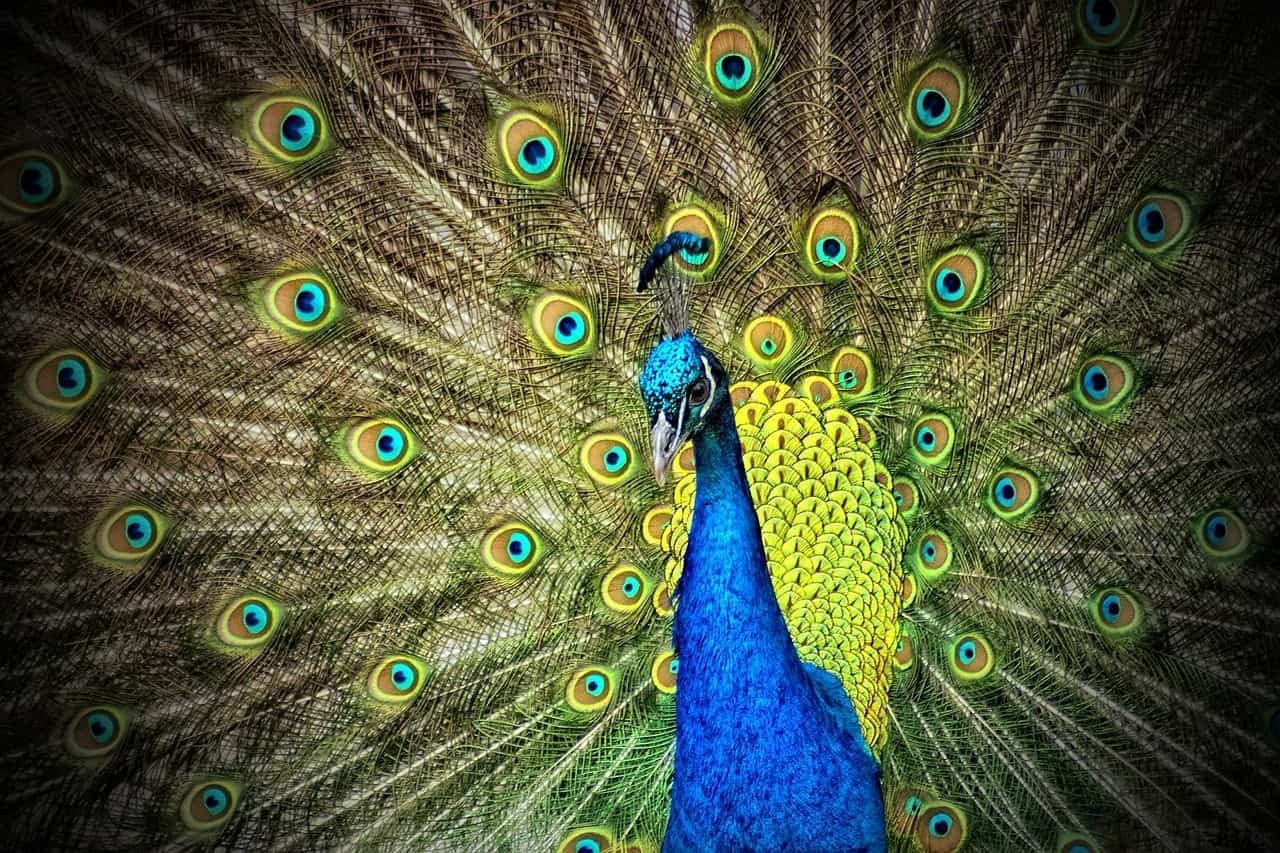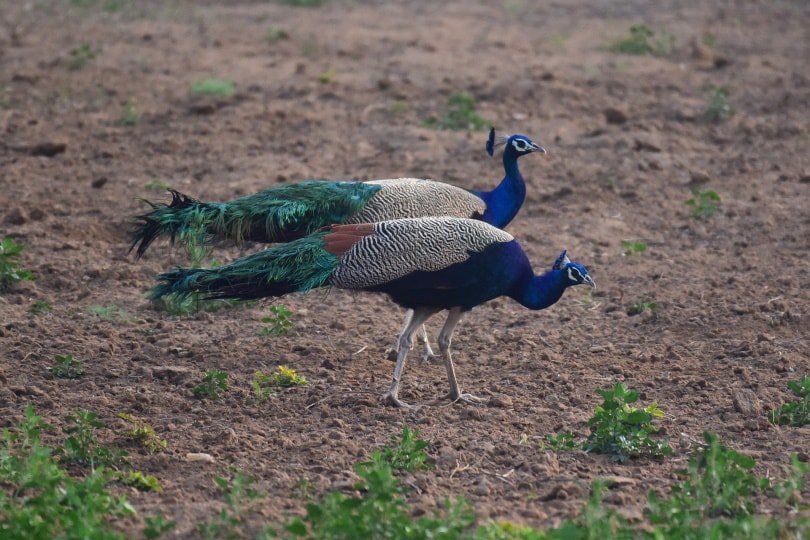There are few birds as majestic or beautiful as the Indian Peafowl. But while the Indian Peafowl are well-known birds, there’s still plenty more that you can learn about them.
Whether you’re thinking of adding one to your homestead or just want to learn a bit more, you’ve come to the right place. We’ll walk you through everything you need to know about both their history and appearances here!

Quick Facts about Indian Peafowl
| Breed Name: | Pavo cristatus |
| Place of Origin: | India and Sri Lanka |
| Uses: | Pest control and meat consumption |
| Peacock (Male) Size: | 39 to 47 inches long, and 9 to 13 pounds |
| Peahen (Female) Size: | 37 inches long, and 6 to 9 pounds |
| Color: | Blue, green, bronze, white, gray, and brown |
| Lifespan: | 10 to 25 years |
| Climate Tolerance: | Warm climates — cannot get below freezing |
| Care Level: | High — expert level |
| Production: | Low |
Indian Peafowl Origins
As the name implies, the Indian Peafowl finds their roots in Asia — more specifically, India and Sri Lanka. But while that’s where the Indian Peafowl originated, modern peafowl have migrated throughout much of the region.
Today, you can find them throughout Pakistan and almost anywhere south of the Himalayan mountains.

Indian Peafowl Characteristics
Most Indian Peafowl are friendly creatures that do well around humans, but occasionally, they can lash out if they feel threatened. Due to their large size, they can cause damage when this happens, especially to children.
Keep in mind that while a domesticated Indian Peafowl can seem tame enough around people, that doesn’t mean they’re necessarily easy to care for. They have destructive personalities, and their large size means you need plenty of space for them.
Still, whether it’s a wild peafowl or a domesticated one, they’re well known for the colorful plumage on the peacock. While the peahen doesn’t have this same bright plumage, they can still be impressive in their own right.
Each one of the dramatic tail feathers on the peacock and the drab ones on the peahen, can take up to 3 years to grow, and they shed them regularly. It’s partly due to these large and beautiful feathers that the Indian Peafowl is India’s National Bird.

Uses
While peafowl are among the largest birds in the world, the truth is that there are not many purposes for them. If you’re thinking of bringing them in for egg production, know that the average peahen only pushes out 20 eggs a year!
You can raise peafowl for meat consumption, or you can keep a few around for pest control. Just keep in mind that they’ll also destroy your local vegetation if you have any.
Appearance & Varieties
Indian Peafowl are extremely large birds with a distinct coloring that sets them apart from many other fowl. They typically have a blue-green plumage around their neck and body, but these colors can vary.
The rarest Indian Peafowl are completely white, but even with an an-all white appearance, these are majestic and impressive-looking birds. However, if you’re thinking of their large and colorful plumage, that’s only on the male peacocks.
This train can reach 4 to 5 feet in length, and its brightly colored and patterned appearance is a signature part of their mating ritual.

Population, Distribution & Habitat
Currently, there are about 100,000 Indian Peafowl in the wild, and the IUCN has them listed under the category of “Least Concern.” That means while there’s not a ton of Indian Peafowl out there, the current population is stable.
Today, you can find Indian Peafowl in India, Sri Lanka, Pakistan, parts of Africa, and even Australia. Still, in many countries, including India, they enjoy a protected status to keep their wild populations healthy and thriving.
Are Indian Peafowl Good for Small-Scale Farming?
The Indian Peafowl is a large bird that typically does well in captivity, but that doesn’t mean they’re easy to care for. Peafowls need a large amount of space, and if they feel threatened, their otherwise friendly demeanor can turn violent.
However, while a peacock can be challenging to care for, the real reason that they’re not good for small-scale farming is that they don’t have a ton of uses and aren’t an economical investment.
If you’re a small-scale farmer, it’s easier and more financially savvy to stick with chickens and other types of fowl!
See also:
Featured Image Credit: Piqsels
